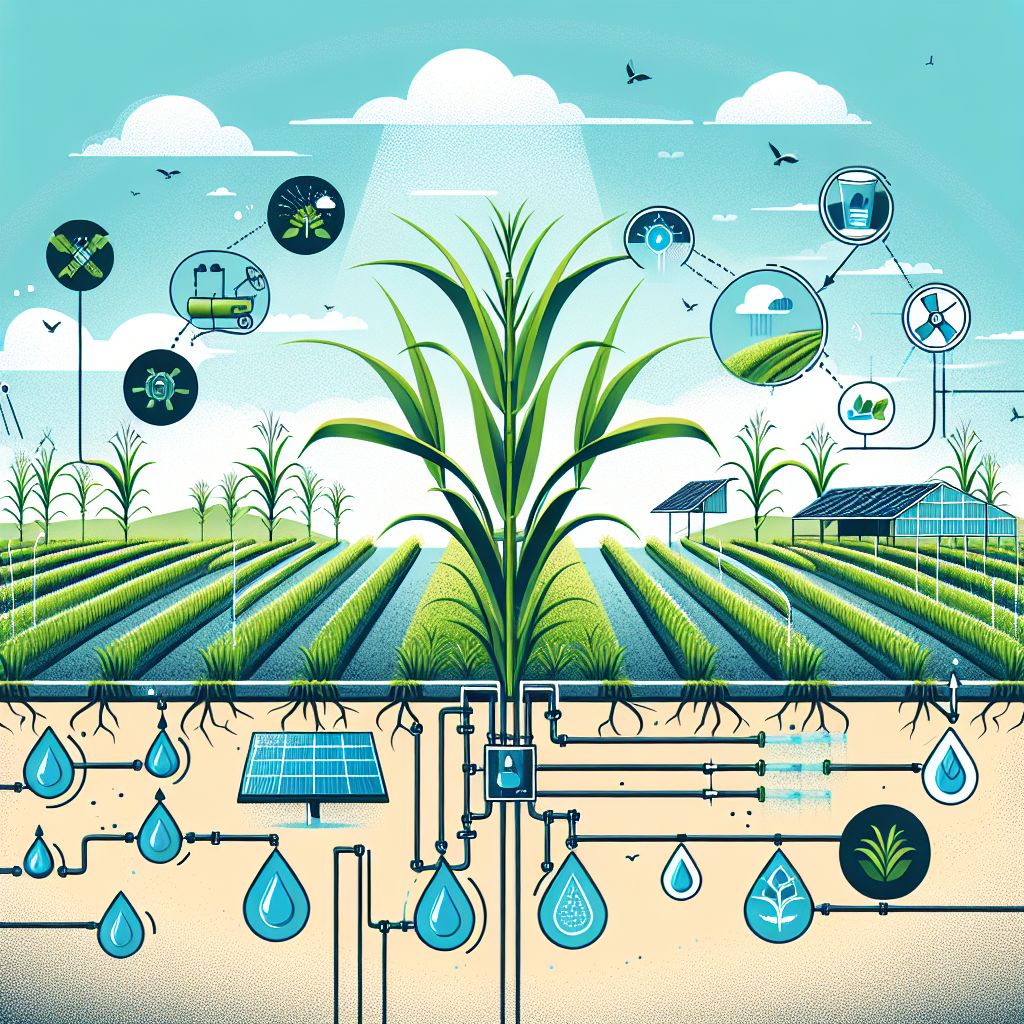
Main Points
Effective watering systems for sugarcane are vital to get the most out of your crop and save water.
Drip irrigation is usually the best way to go as it delivers water straight to the plant’s roots, reducing waste.
Understanding the different growth stages of sugarcane helps you know when to water for the best growth.
Using solar-powered watering systems can help reduce running costs and promote eco-friendly farming.
Technology such as remote monitoring and soil moisture sensors are changing the game in sugarcane watering.
When you’re growing sugarcane, water is as precious as gold. Not enough and the cane won’t grow; too much and you’re just wasting money. So, let’s take a look at effective sugarcane watering systems, where every drop of water is precious and every decision can make a big difference to your crop.
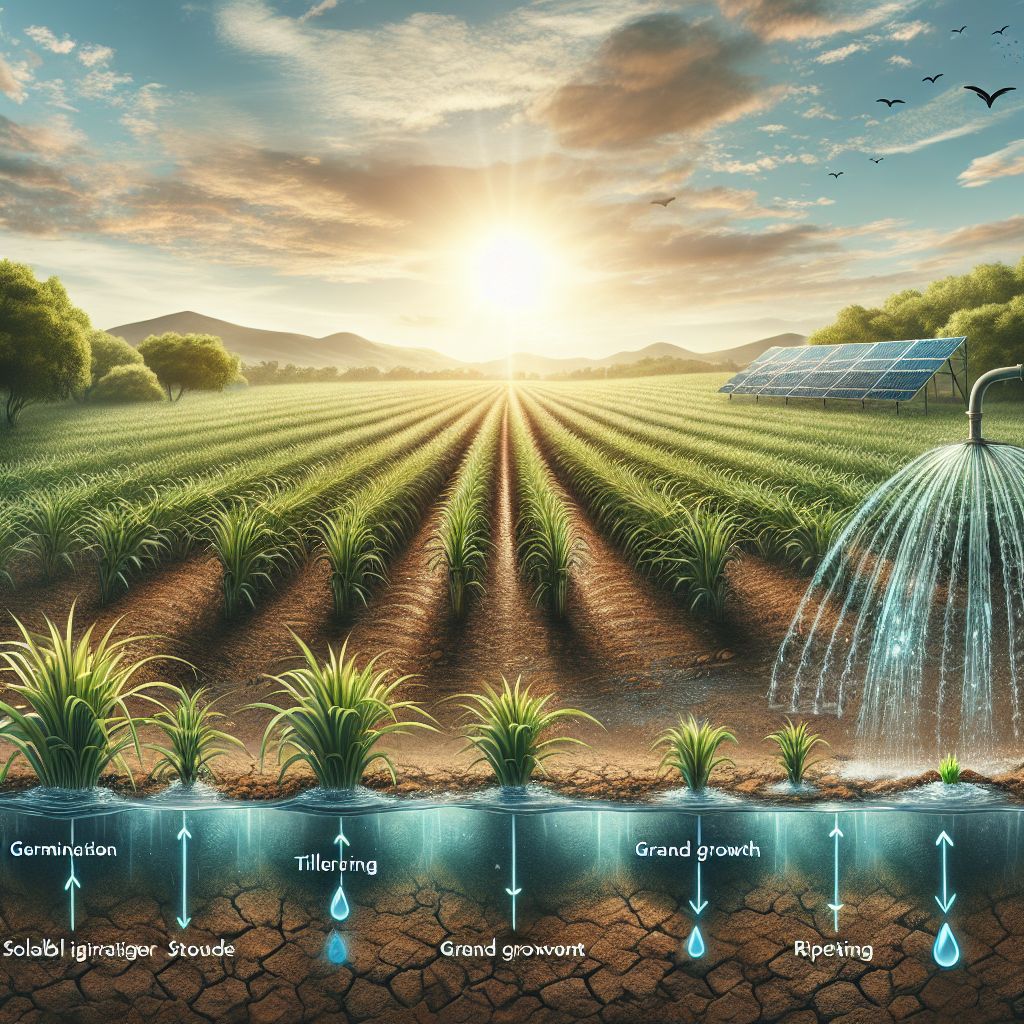
The Importance of Solar Irrigation in Sugarcane Cultivation
Sugarcane is a water-loving plant. It requires a steady and abundant supply of water, which makes irrigation systems more than just beneficial, they’re essential. But it’s not just about giving the plant what it needs, it’s about doing it intelligently. Solar irrigation combines the plant’s need for water with the energy of the sun, offering an energy-efficient solution to a resource-demanding issue.
Utilizing Solar Energy for Irrigation
Picture this: using the sun’s power to provide water for your crops. That’s what solar irrigation is all about. Photovoltaic panels power the pumps, transforming the sun’s energy into the energy required to irrigate your sugarcane. This results in reduced electricity costs, decreased dependence on non-renewable energy sources, and a well-watered, healthy crop.
The Importance of Regular Water Supply
When it comes to irrigating sugarcane, regularity is everything. The plant’s growth cycle has unique water requirements at various stages, and the ability to meet these needs efficiently is what distinguishes successful farmers. Solar-powered irrigation systems provide the dependability required to keep a regular water supply, guaranteeing that the plant receives precisely what it needs, exactly when it needs it.
Water Needs at Different Stages of Sugarcane Growth
Sugarcane grows in four primary stages: germination, tillering, grand growth, and ripening. Each of these stages requires different amounts of water. For example:
Germination: The sugarcane needs a damp soil to begin sprouting.
Tillering: As the sugarcane starts to shoot, it needs water to help new stalks grow.
Grand growth: This is when the sugarcane grows the fastest and needs the most water.
Ripening: The sugarcane needs less water as it gets ready to be harvested.
Knowing these stages will help you plan when to water your sugarcane to help it grow healthy and produce a high yield. For more information on sugarcane irrigation management, visit our detailed guide.
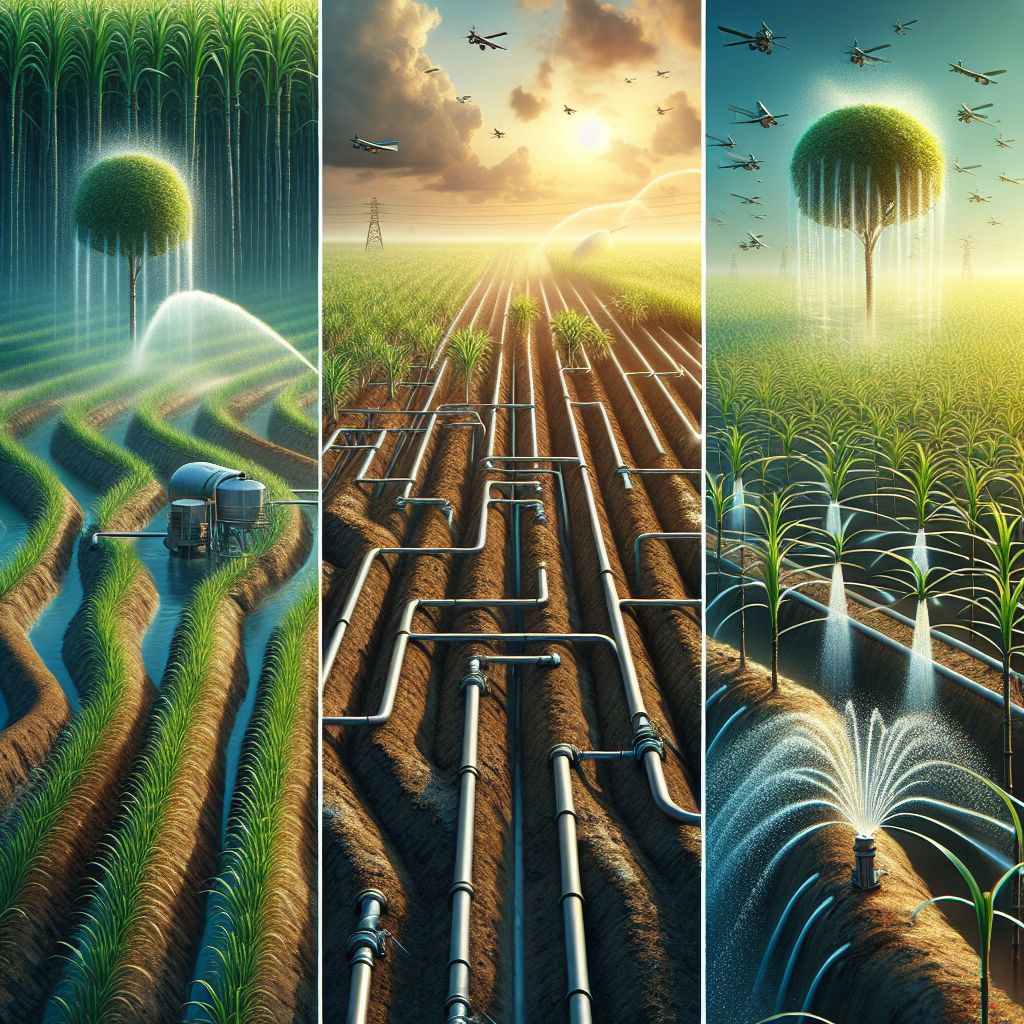
Investigating Different Sugarcane Irrigation Systems
Watering a sugarcane field isn’t a one-size-fits-all task, and each method has its advantages. Let’s delve into the primary irrigation systems to discover the best match for your crop.
The Pros and Cons of Furrow Irrigation
Furrow irrigation is the equivalent of the farmer’s old reliable workhorse. It’s a time-tested method that has been used for generations. Water is channeled between crop rows, sinking into the soil to nourish the roots of the plants. While this method is straightforward and economical, it is not without its disadvantages.
Even though furrow irrigation is less costly to set up, it doesn’t use water most efficiently. Evaporation or runoff can result in substantial water loss, and it’s more challenging to manage the water distribution to each plant.
When to Use Sprinkler Irrigation
Sprinkler systems are the rainmakers of irrigation. They simulate natural rainfall by showering water over the crop. They’re a good choice for uneven terrain where other systems might have difficulty. However, they can also be less efficient than other methods, as some of the water evaporates before it reaches the ground.
Drip Irrigation: Getting the Most Bang for Your Buck
Now, let’s discuss the main event: drip irrigation. This method is the sniper of watering systems, delivering hydration straight to the plant’s roots via a series of tubes. The outcome? Less water down the drain and more money in your pocket.
Notably, drip irrigation is not only about water. It can also be employed to deliver nutrients directly to the plant, which can result in healthier crops and improved yields. However, it does come with a higher initial cost and needs meticulous management to avoid clogging and damage to the system.
However, it’s not just the irrigation method that matters. Timing and accuracy are key. You have to water the sugarcane at the correct time and in the correct quantities to ensure that every drop of water is used to cultivate a healthy crop.
Here is a table exploring the different types of irrigation systems for sugarcane:
|
Irrigation System |
Description |
Advantages |
Disadvantages |
|---|---|---|---|
|
Furrow Irrigation |
Water flows through small parallel channels or furrows between the rows of sugarcane. 1, 3, 5 |
– Low water use efficiency. 1, 3, 5 | |
|
Overhead Sprinkler |
Water is sprayed onto the crop from overhead sprinklers or water cannons. 1, 3 |
– Suitable for various topographies. 1 |
– High labor requirement. 1 |
|
Drip Irrigation |
Water is applied directly to the root zone through a network of pipes and emitters. 1, 3, 5 |
– High water use efficiency. 1, 2, 3 |
Furrow irrigation is widely used for sugarcane due to its low cost and simplicity, but suffers from low water use efficiency and potential waterlogging issues. 1, 3, 5
Sprinkler irrigation allows for fertigation but has high operating costs and is susceptible to wind drift. 1, 3Drip irrigation, especially subsurface drip irrigation (SDI), offers very high water use efficiency, precise fertigation, and reduced disease pressure, but at a higher initial cost. 1, 2, 3
The choice depends on factors like water availability, soil conditions, topography, and economic considerations. Drip irrigation systems are increasingly preferred for sugarcane due to their water savings and yield benefits. 2, 3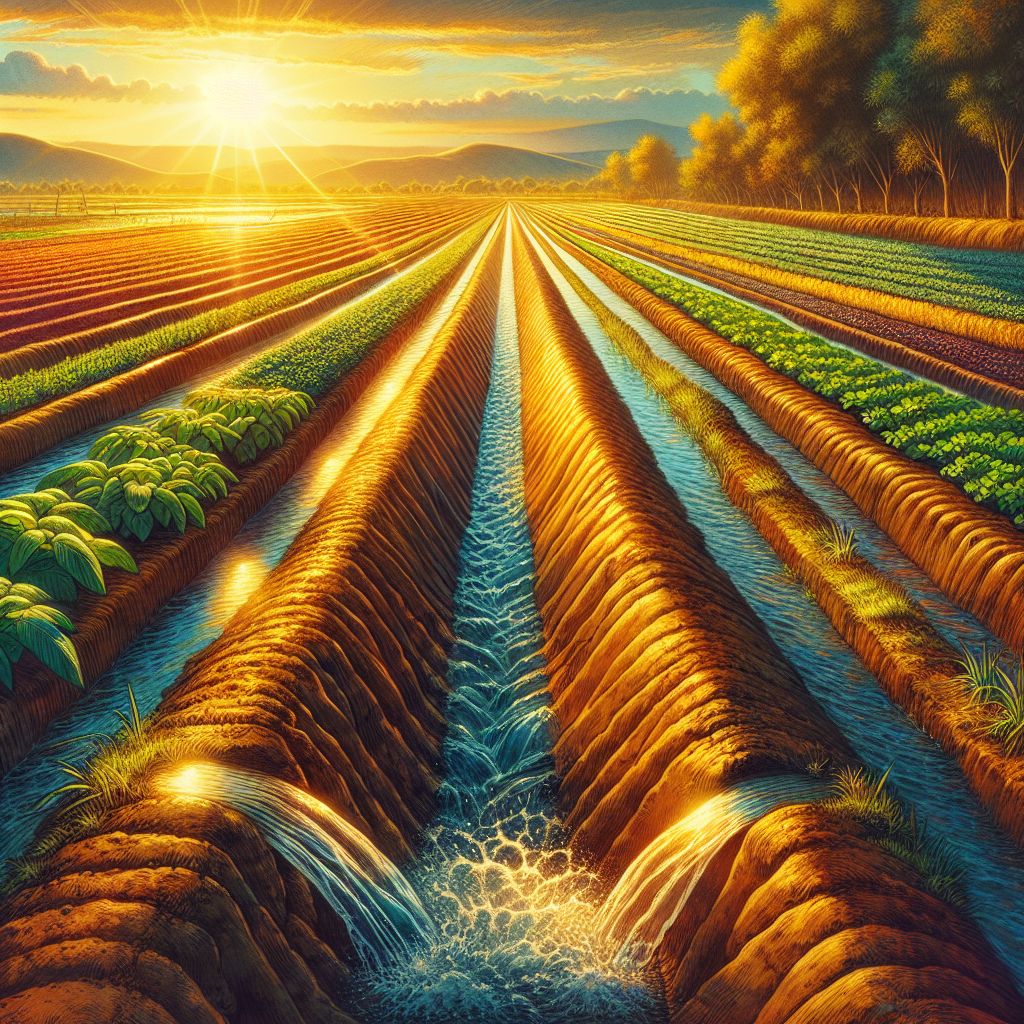
Furrow Irrigation: The Classic Watering Method
Let’s rewind a bit and discuss furrow irrigation. This is the classic method of watering crops, and it’s been in use for hundreds of years. It involves creating small channels between rows of crops and allowing water to flow through them to reach the roots of the plants. Sounds easy, doesn’t it? But let’s delve a little further.
Quick Overview of the Furrow Irrigation System’s History
The origins of furrow irrigation can be traced back to old farming methods. It’s a shining example of human creativity, adjusting to different terrains and water supplies. The fundamental concept has remained relatively unchanged over time: use gravity and the land’s natural contours to direct water to your crops.
Is Furrow Irrigation Still Worth It?
So, is furrow irrigation still worth it today? It can be, particularly for farmers who are on a tight budget and have flat fields. However, since it’s not the most water-efficient method, it’s becoming less popular compared to more modern systems, especially in areas where water is scarce.
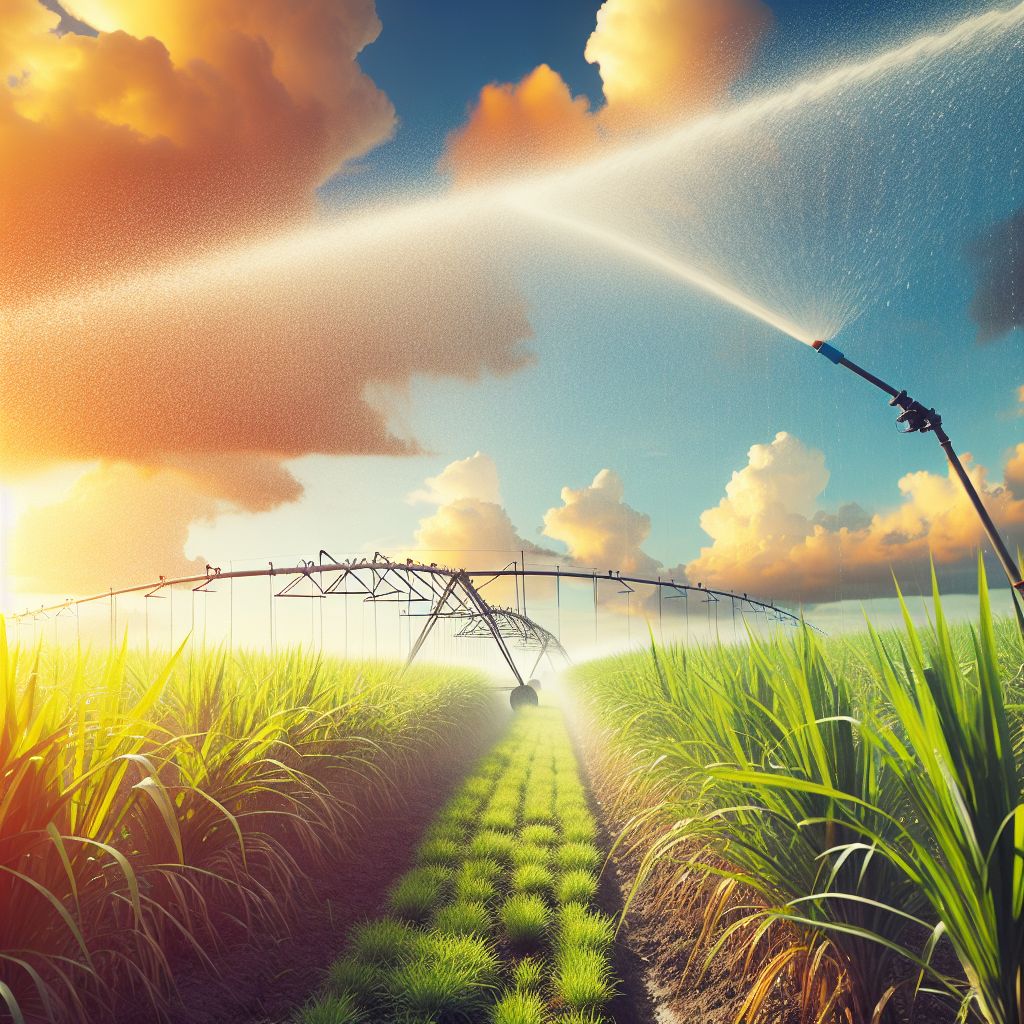
Give Your Sugarcane a Shower: Sprinkler Irrigation
Think of sprinkler irrigation as a refreshing rain shower for your sugarcane. It’s flexible, can water a wide area, and is generally simple to install. However, like all methods, it has its pros and cons.
Advantages of Sprinkler Irrigation Systems
These are the reasons why some farmers prefer sprinkler systems:
They offer uniform watering across the entire field.
Sprinklers can be adjusted to accommodate different types of land and terrain.
They can also be used to prevent frost damage or to cool the crop on hot days.
Reasons Why a Farmer Might Not Use a Sprinkler Irrigation System
So why might some farmers decide to pass on sprinklers? Here’s the lowdown:
Water can evaporate before it ever reaches the ground, particularly on hot or windy days.
They may require more upkeep and are susceptible to wind distortion.
If the water pressure isn’t exactly right, some spots can be too dry or too waterlogged.

Drip Irrigation: The Pinnacle of Efficiency
Let’s now crown the king: drip irrigation. This system is all about precision. It provides water drop by drop, right where the plant can best use it—its roots. This results in less waste, less evaporation, and more water reaching where it’s needed.
Does Drip Irrigation Reign Supreme for Sugarcane Cultivation?
In the realm of sugarcane cultivation, think of drip irrigation as the trusted courtier—knowledgeable, efficient, and immensely beneficial. It enables you to provide sugarcane with precisely what it requires, avoiding the surplus that could cause weed growth or waterlogging.
Why a Farmer Might Not Choose the Drip Irrigation System
So, why might a farmer not want to use drip irrigation? It’s not always the best choice:
Initial expenses might be more than other methods.
Proper installation and maintenance are necessary to avoid blockages and harm.
There’s a slight adjustment period to get everything working seamlessly.
However, those who dedicate the necessary resources often discover that the advantages surpass the disadvantages.
Now, let make the irrigation system you picked even more efficient with solar panels.
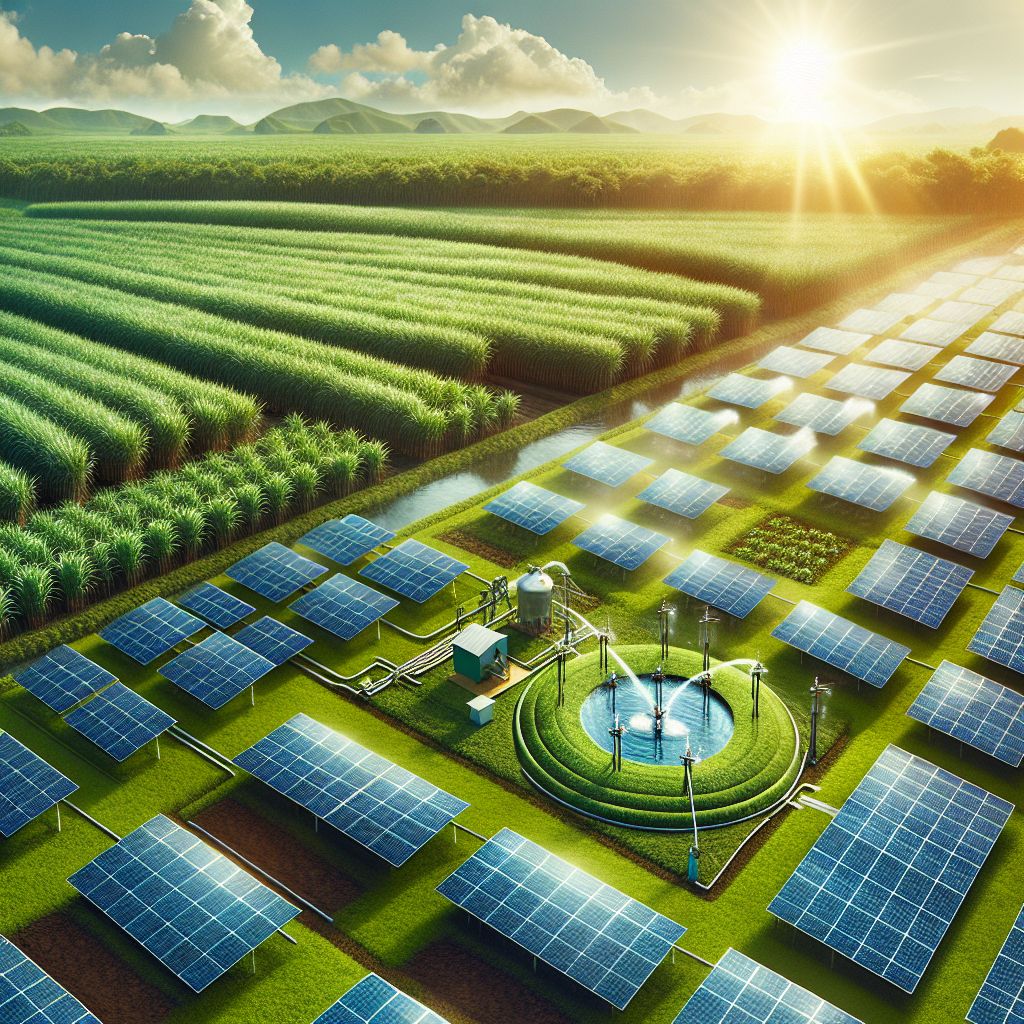
Boosting Irrigation System Efficiency with Solar Panels
Let’s take the efficiency of your irrigation system to the next level by introducing solar panels. These panels can provide the energy needed for your irrigation system, reducing energy expenses and making your operation more eco-friendly.
Here is a table showing the different solar panels that can be used with an irrigation system:
|
Panel Type |
Pros |
Cons |
|---|---|---|
|
Monocrystalline |
– Highest efficiency in converting sunlight to electricity (around 20%). 1, 2 | |
|
Polycrystalline |
– More affordable than monocrystalline. 1, 2 |
– Lower efficiency and shorter lifespan than monocrystalline. 1, 2 |
|
Thin-Film |
– Lightweight and flexible for unique installations. 1, 2 |
– Lowest efficiency (around 7-13%). 1, 2 |
Combining Solar Power and Irrigation Systems
It’s all about working together. Solar panels soak up the sun’s energy, which can then be used to run pumps and other irrigation tools. This means you’re using a renewable resource to grow your crops, which is beneficial for the environment and your wallet.
Lowering Running Costs Through Green Energy
By utilizing solar energy for irrigation, you can significantly cut down on running costs. Once you’ve made the initial investment in solar panels, the energy they generate is basically free. Moreover, you could potentially receive incentives or rebates for using green energy.
Real Life Examples: The Success of Solar-Powered Irrigation
Take, for example, a sugarcane farm in Brazil that switched to solar-powered drip irrigation. They saw a 20% increase in yield and a 30% reduction in water usage. That’s a win-win situation.
And it’s not just big farms that can benefit. Smaller operations are finding that solar irrigation systems can be scaled to fit their needs, making them a smart choice for all kinds of growers.
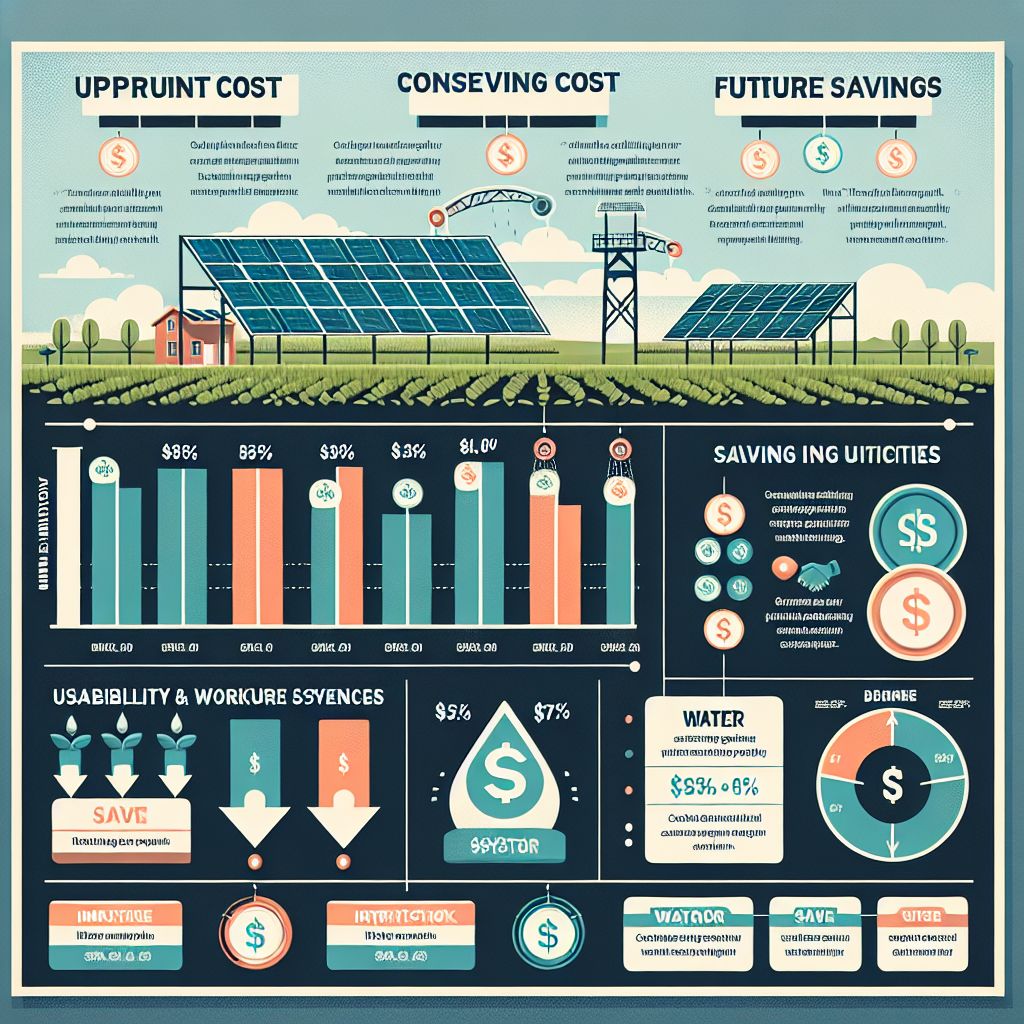
Breaking Down the Costs and Benefits of Various Solar Irrigation Techniques
Let’s get down to brass tacks. Solar irrigation might look expensive on the surface, but let’s take a closer look:
Upfront Cost vs. Future Savings
Indeed, you’ll need to make an initial investment. However, thanks to the savings on energy expenses, most systems will pay for themselves in a few years. From then on, it’s all profit.
Conserving Water and Saving on Utilities
By using an efficient irrigation system, you’re not only conserving water, which is great for the environment, but you’re also saving on your utility bills. Plus, with solar power, you’re not subject to the whims of changing energy costs.
Usability and Workforce Expenses
One more factor to consider is the usability and workforce expenses. Conventional irrigation systems usually need more hands-on work to set up and manage. With solar-powered systems, a lot of the process can be computerized, which saves time and lessens the need for constant work. This computerization can translate to significant cost savings over time, making the initial investment in solar even more enticing.
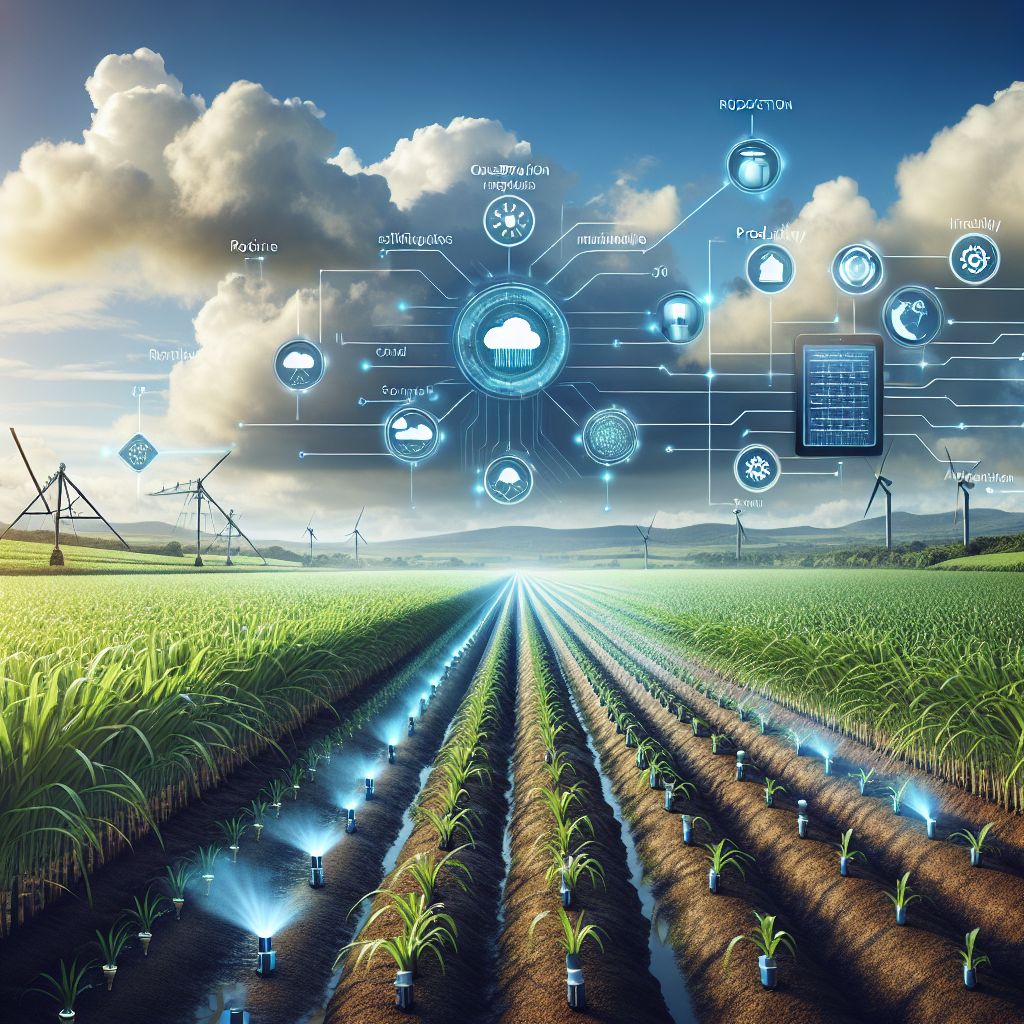
Technological Advances in Sugarcane Irrigation
Modern Innovations in Sugarcane Watering Systems
Modern technology is transforming how we water sugarcane. Thanks to the advent of remote monitoring and automated sensors, managing water use has never been more efficient.
Systems for Remote Monitoring and Control
Remote monitoring systems give you the ability to monitor your irrigation from any location. Using a smartphone or computer, you can ensure everything is operating as it should and make necessary changes. This allows you to address any problems immediately, potentially conserving water and safeguarding your crop.
Self-Regulating Soil Moisture Sensors
Think of self-regulating soil moisture sensors as your crops’ personal helper. They keep a constant eye on the moisture levels in the soil and can set off the irrigation system when it’s needed. This means that your sugarcane will always get the right amount of water at the right time, which cuts down on waste and encourages healthy growth.
These sensors are especially beneficial during the sugarcane’s crucial growth stages. By carefully controlling water use during these stages, you can increase production and enhance the quality of your crop.
Using AI to Schedule Irrigation
The future of farming is here with artificial intelligence (AI). When you combine AI with your irrigation system, you can create a watering schedule based on things like the weather forecast, how your plants are growing, and the condition of your soil. This kind of scheduling can help you be more precise with your irrigation, which can make it more efficient and effective.
Artificial intelligence is also capable of identifying patterns that could signify potential problems, such as leaks or obstructions in the system. By dealing with these problems promptly, you can avoid wasting water and protect your crop from stress.
Final Thoughts:
Irrigation is a key factor in the successful cultivation of sugarcane. Whether you’re using time-tested methods or the newest tech, the aim remains the same: to give your crops the water they need without wasting a drop. By knowing what’s out there and making informed decisions, you can help your sugarcane flourish and your farm thrive.
Keep in mind that every farm is unique and there’s no universal solution. Take into account your land, your resources, and your objectives when selecting the most suitable irrigation system for your sugarcane. Also, always be on the lookout for emerging technologies that can assist you in farming more efficiently, rather than more strenuously.
By using a smart strategy, you can increase your sugarcane yield, reduce your expenses, and contribute to a healthier environment through efficient irrigation. So, take a moment to investigate the possibilities, put money into the best system, and watch your sugarcane grow high and sweet.
Common Questions
Do you have questions? Don’t worry, you’re not the only one. Here are some frequently asked questions about sugarcane irrigation, with answers for you.
What’s the best way to water sugarcane without wasting water?
The best way to water sugarcane without wasting water is to use drip irrigation. This method delivers water straight to the roots of the plant, so no water is wasted and every drop counts.
How can solar panels improve irrigation system efficiency?
Solar panels offer a sustainable energy solution to power irrigation systems, lessening the dependence on grid electricity and lowering operating expenses.
Are advanced solar irrigation systems cost-effective for small-scale farmers?
Yes, solar irrigation systems can be tailored to fit small farms, and with the decreasing costs of solar technology, they are becoming more and more accessible. Plus, the long-term savings on energy can make them a smart investment.
In addition, government subsidies or grants promoting sustainable farming practices can help small-scale farmers offset the initial costs.
Moreover, the enhanced water efficiency and potential for increased yields could lead to improved profits, making the investment in solar irrigation a wise decision for small-scale farmers.
What is the recommended maintenance schedule for solar irrigation systems to ensure they work efficiently?
|
Maintenance Activity |
How often should it be done? |
|---|---|
|
Clean the solar panels |
Every month |
|
Check for any physical damage |
After any harsh weather |
|
Keep an eye on the system’s performance |
Every day |
|
Get a professional to check the system |
Once a year |
It’s important to keep your solar irrigation system in good condition to ensure it works efficiently. Regular checks and cleanings will help it last longer and work better.
How does technology affect sugarcane irrigation today?
Technology is at the heart of modern sugarcane irrigation, providing the tools to manage water accurately, reduce wastage, and increase crop yields. Developments such as remote monitoring, automated sensors, and predictive scheduling driven by AI are changing the way farmers irrigate their crops.







Leave a Reply